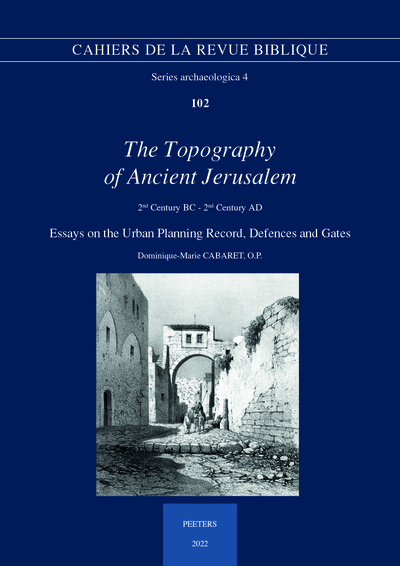- EAN13
- 9789042948198
- Éditeur
- PEETERS
- Date de publication
- 22 février 2022
- Collection
- CAHIERS DE LA R
- Nombre de pages
- 381
- Dimensions
- 30 x 21 x 2,5 cm
- Poids
- 1640 g
- Langue
- eng
The Topography Of Ancient Jerusalem. 2nd Century Bc - 2nd Century Ad, Essays On The Urban Planning Record, Defences And Gates
Cabaret D.-M.
PEETERS
Prix public : 101,76 €
Jerusalem had a turbulent history and an urban evolution, which we find described by the historians of Antiquity. For 130 years attempts have been made to trace the lines of the ramparts, understand the sieges, reconstruct the great buildings and reveal the underlying planning. Crusader eyes first discerned the great monuments, long since vanished: Herod’s Temple, Hadrian’s Capitoline temple and Justinian’s long Christian basilica. All they had in front of them was the wall of the Temple, Constantine’s Holy Sepulchre and the Dome of the Rock. They scrutinized Jerusalem tirelessly, with a skill and a passion that still demand respect, and they felt they knew the city. Jerusalem has become a subject that arouses curiosity around the world. The ever-increasing quantity of interdisciplinary research is bringing new documents to light every day. Old maps, the potential of pre-1914 photographs found tucked away in drawers, and the availability of new technologies like satellite photography and computer data-processing are radically changing the methods of investigation. Dominique-Marie Cabaret tackles the whole complexity of the city head-on. Respectfully taking the current state of knowledge on board he conducts his investigation with the analytical skill of an engineer. His alternative approach has opened up new insights for him. Living on the spot, and familiar with the city from years of walking the streets and alleys, secret places, squares and courtyards, he has sought to test his intuitions armed with a pencil, a ten-metre tape-measure and a calculator. He found himself able to discern the geometry of the great works in the districts of the Hasmonean princes, then those of Herod and the whole area of Hadrian’s Aelia Capitolina, transformed by the ravages of time but with their organisational principles still intact. The intersections of the city’s main thoroughfares bear the marks of their ideologies. The sites of the great buildings have left the imprint of their policies or their competing propaganda. Cabaret radically changes our view of ancient Jerusalem. His watchmaker skills are put to excellent use as he describes the city planning grids and places them in relation to each other. Our curiosity builds as we follow along in his text. The city’s quarters were founded by the Hasmonean kings in the second century BC and the Damascus Gate square opens into an agora. To the north of the Temple, Herod prepared a quarter for a theatre and its quadriporticus. The Ecce Homo Arch comes back to life as a Herodian gate set in the city’s Second Wall. His ambitious grandson Herod Agrippa extended the city to the north, and this is where the Tomb of the Kings has its place. Everything changed following the destruction of the Temple to accommodate the Tenth Legio Fretensis inside the city walls. Jerusalem was embellished by Hadrian, who made it a Roman colony where he himself and Jupiter were to be worshipped, on the site of the Holy Sepulchre, and the equestrian statue of Hadrian was given pride of place on a sacred platform of the former Jewish Temple. The bold thesis of this work will breathe new life into what promises to become a fruitful debate.


















